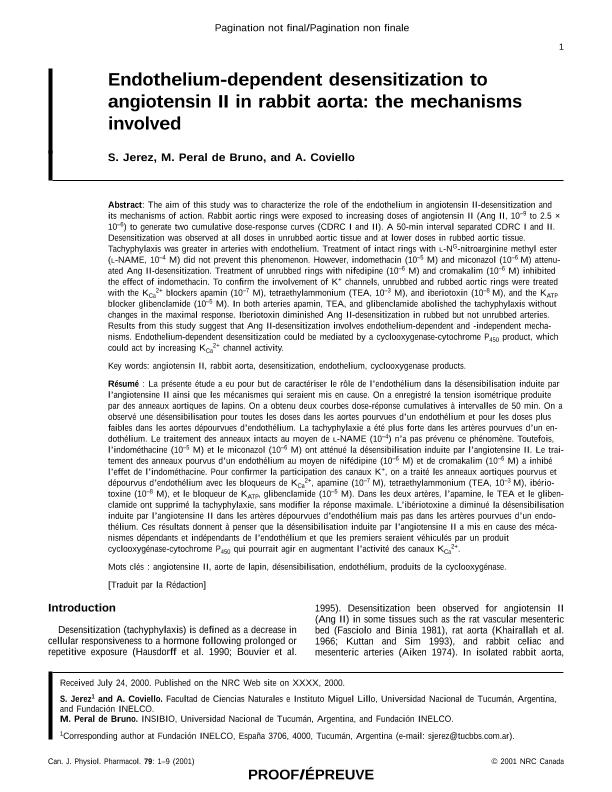Artículo
The aim of this study was to characterize the role of the endothelium in angiotensin II-desensitization and its mechanisms of action. Rabbit aortic rings were exposed to increasing doses of angiotensin II (Ang II, 10–9 to 2.5 × 10–6) to generate two cumulative dose-response curves (CDRC I and II). A 50-min interval separated CDRC I and II. Desensitization was observed at all doses in unrubbed aortic tissue and at lower doses in rubbed aortic tissue. Tachyphylaxis was greater in arteries with endothelium. Treatment of intact rings with L-NG-nitroarginine methyl ester (L-NAME, 10–4 M) did not prevent this phenomenon. However, indomethacin (10–5 M) and miconazol (10–6 M) attenuated Ang II-desensitization. Treatment of unrubbed rings with nifedipine (10–6 M) and cromakalim (10–6 M) inhibited the effect of indomethacin. To confirm the involvement of K+ channels, unrubbed and rubbed aortic rings were treated with the KCa 2+ blockers apamin (10–7 M), tetraethylammonium (TEA, 10–3 M), and iberiotoxin (10–8 M), and the KATP blocker glibenclamide (10–5 M). In both arteries apamin, TEA, and glibenclamide abolished the tachyphylaxis without changes in the maximal response. Iberiotoxin diminished Ang II-desensitization in rubbed but not unrubbed arteries. Results from this study suggest that Ang II-desensitization involves endothelium-dependent and -independent mechanisms. Endothelium-dependent desensitization could be mediated by a cyclooxygenase-cytochrome P450 product, which could act by increasing KCa 2+ channel activity. La présente étude a eu pour but de caractériser le rôle de l’endothélium dans la désensibilisation induite par l’angiotensine II ainsi que les mécanismes qui seraient mis en cause. On a enregistré la tension isométrique produite par des anneaux aortiques de lapins. On a obtenu deux courbes dose-réponse cumulatives à intervalles de 50 min. On a observé une désensibilisation pour toutes les doses dans les aortes pourvues d’un endothélium et pour les doses plus faibles dans les aortes dépourvues d’endothélium. La tachyphylaxie a été plus forte dans les artères pourvues d’un endothélium. Le traitement des anneaux intacts au moyen de L-NAME (10–4 M) n’a pas prévenu ce phénomène. Toutefois, l’indométhacine (10–5 M) et le miconazol (10–6 M) ont atténué la désensibilisation induite par l’angiotensine II. Le traitement des anneaux pourvus d’un endothélium au moyen de nifédipine (10–6 M) et de cromakalim (10–6 M) a inhibé l’effet de l’indométhacine. Pour confirmer la participation des canaux K+, on a traité les anneaux aortiques pourvus et dépourvus d’endothélium avec les bloqueurs de KCa2+, apamine (10–7 M), tetraethylammonium (TEA, 10–3 M), ibériotoxine (10–8 M), et le bloqueur de KATP, glibenclamide (10–5 M). Dans les deux artères, l’apamine, le TEA et le glibenclamide ont supprimé la tachyphylaxie, sans modifier la réponse maximale. L’ibériotoxine a diminué la désensibilisation induite par l’angiotensine II dans les artères dépourvues d’endothélium mais pas dans les artères pourvues d’un endothélium. Ces résultats donnent à penser que la désensibilisation induite par l’angiotensine II a mis en cause des mécanismes dépendants et indépendants de l’endothélium et que les premiers seraient véhiculés par un produit cyclooxygénase-cytochrome P450 qui pourrait agir en augmentant l’activité des canaux KCa2+.
Endothelium-dependent desensitization to angiotensin II in rabbit aorta: the mechanisms involved
Fecha de publicación:
12/2001
Editorial:
Canadian Science Publishing
Revista:
Canadian Journal Of Physiology And Pharmacology
ISSN:
0008-4212
e-ISSN:
1205-7541
Idioma:
Inglés
Tipo de recurso:
Artículo publicado
Clasificación temática:
Resumen
Archivos asociados
Licencia
Identificadores
Colecciones
Articulos(INSIBIO)
Articulos de INST.SUP.DE INVEST.BIOLOGICAS
Articulos de INST.SUP.DE INVEST.BIOLOGICAS
Citación
Jerez, Susana Josefina; Peral, Maria de Los Angeles; Coviello, Alfredo; Endothelium-dependent desensitization to angiotensin II in rabbit aorta: the mechanisms involved; Canadian Science Publishing; Canadian Journal Of Physiology And Pharmacology; 79; 6; 12-2001; 481-489
Compartir
Altmétricas




